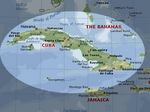Tourism is restoring the buildings of Old Havana
Miami Herald- Mike Williams
March 21st, 2007 - It's one of the hemisphere's architectural treasures, but in a country of scarce resources, saving the crumbling buildings of Old Havana might easily have been overlooked.
Instead, Cuba has slowly but steadily restored some of the oldest -- and most gorgeous -- buildings in the Americas. The innovative plan has also funded social programs and housing reconstruction, making it a model for historic districts around the world, experts say.
''It's a self-financing, self-sustaining model,'' said Herman Van Hooff, a United Nations cultural official based in Havana. ``It's an integrated vision of restoration and providing services to the population. It has matured into a model with valuable concepts for other places.''
The unique part of Cuba's plan has been its strategy of restoring old hotels, restaurants and buildings to attract tourists and then using tourism revenue to fund more restoration, along with social programs and housing renovation, one of Cuba's most pressing problems.
But the work hasn't been without its challenges.
One of the biggest problems facing planners is also a main source of Old Havana's charm: The district's narrow streets are packed with people, with some 66,000 residents crammed into an area of less than 1.5 square miles.
Water and sewer lines are in poor condition, and some buildings have already collapsed. On many streets, visitors see crumbling facades, leaning walls and teetering roofs propped up with wooden scaffolding.
FAMILIES STAY
But families continue living in even the most dilapidated buildings. Old men play dominoes on street corners, younger men tinker under the hoods of ancient cars and housewives hang wash from wrought-iron balconies, pausing to peer at the busy street life below.
Small wonder that few of the residents want to leave. The district's charm -- and the opportunity to make money from the thousands of tourists strolling its streets -- are powerful attractions.
Planners have responded by constructing new apartments in refurbished old buildings, allowing many families who want to stay in the district to remain. The pace is slow, but as the tourism infrastructure has expanded, more revenues are being channeled into social programs. While only 57 buildings were restored between 1981 and 1993, nearly 300 were refurbished between 1994 and 2004.
Belkys Collaza is one resident who has moved out of a decaying building and into a spacious new apartment provided by the Cuban government at low cost.
''We couldn't be happier,'' said Collaza, 39. ``In the old apartment we had seven people with two bedrooms and it was falling down. Here we have three bedrooms for four people, and best of all, we are still in Old Havana.''
Havana's roots stretch back to the early 1500s, when its deep, protected harbor made it the perfect spot to assemble the famous treasure fleets that took New World gold and silver back to Spain.
By 1750, the city was a thriving commercial and government center with striking buildings in the baroque and neo-classical styles. Expansion continued during the 1800s as Cuba became a rich sugar and tobacco colony.
A LONG DECLINE
But Old Havana -- the city's district next to its port -- began a long decline as the rich built mansions on the city's outskirts and new business districts cropped up.
Restoration efforts date back to the 1930s, but the work was poorly funded. Even after Fidel Castro's 1959 revolution, Cuba's focus was on developing agriculture and raising living standards for the rural poor. Old Havana continued to deteriorate, despite the efforts of the Office of the Havana Historian.
While the district was officially declared a protected national monument in 1978 and designated as a World Heritage Site by the United Nations in 1982, only a few dozen buildings were restored in the 1980s.
A new setback came in the early 1990s with the collapse of the Soviet Union, which for decades had provided billions in subsidies to Cuba.
But Cuba turned to tourism to revive its economy, and Old Havana became a key part of the plan.
Félix Alfonso, a Cuban historian involved in the project, admitted that Old Havana's complete restoration will take decades. But he's encouraged that the enterprise is financing itself and keeping the residents in the district they love.
''I think what makes the restoration unique is that it's an example not of gentrification, where the rich buy and restore buildings while the poor are moved out,'' he said. ``Our historical center is remaining a place where people live and work.''
Link to Story: http://www.miamiherald.com/884/story/47876.html
Wednesday, April 4, 2007
Subscribe to:
Post Comments (Atom)

No comments:
Post a Comment